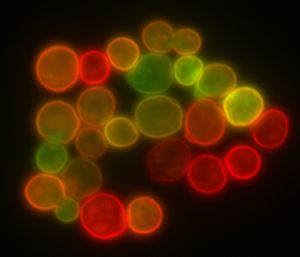Yeast
Yeast Free Cooking Manual & Cookbook
“Discover Why What You Are Eating Is Finishing You Off!”
-
All recipes are free of yeast, mold and fermented foods
-
All recipes are free of refined sugar and refined grains of any kind
Get Ready To Discover The Web’s TOP
Yeast Free Recipes And Tips Right Now!
Yeasts are organisms in the fungi kingdom. Of the 1,500 or so species of yeasts that have been discovered so far, two are of particular interest to people with allergies: Saccharomyces cerevisiae (used in baking and brewing) and Candida albicans (responsible for candidiasis i.e. yeast infections).
Other species of yeast are involved in both food production (useful) and infection. This article is confined to discussing Saccharomyces cerevisiae and Candida albicans.
Yeast and Food
 The use of yeast to produce food and alcohol is an ancient practice. It is particularly useful for producing bread and beer.
The use of yeast to produce food and alcohol is an ancient practice. It is particularly useful for producing bread and beer.
Depending on your tolerance for yeast, you may be able to have a limited quantity of some types of food that use yeast.
Bread
In bread, the growth of yeast releases carbon dioxide, which forces the bread to rise. Yeast does not survive the baking process, but many of the allergy-causing proteins do. For this reason, you may find that bread causes problems if you are allergic to yeast. It may also be one reason that some people feel fatigue after eating bread.
Yeast Extract
Some foods made primarily of yeast. See Foods That Always Contain Yeast on this website.
Beer and Wine
Yeast produces alcohol during beer brewing and wine fermentation. It also causes the fizz in beer and some sparkling wines. The yeast in beer and wine can be alive when you drink it. For this reason, beer and wine are especially bad for people with a yeast allergy. It can also cause fatigue after drinking beer or wine.
Distilled Alcohol
Yeast is used in the fist stage of alcohol production. Spirits such as rum, whisky and brandy. The distilling process concentrates the alcohol and leaves most of the yeast behind. Vodka and gin are especially pure and generally safe for people who must avoid yeast. Some methods of distilling are less efficient. Some types of single malt whisky for example, may have higher levels of yeast than a typical blended product. This level may or may not be within your tolerance for yeast intake.
Yeast Infections
The most common type of yeast infection is caused primarily by Candida albicans. This is not an allergy, but if you are allergic to yeast, a yeast infection may cause you to suffer both from the direct symptoms of a yeast infection as well as your yeast allergy symptoms.
Homeopathic Yeast Remedy
“Eases multiple symptoms of
yeast infection in both Men and Women”
Related Articles
- Foods that Contain Yeast
- Yeast Allergy
- Types of Yeast
- Tired After Eating Bread
- Tired After Drinking Beer or Wine
- Top 20 Food Allergies with Delayed Reactions
{ 13 comments… read them below or add one }
← Previous Comments